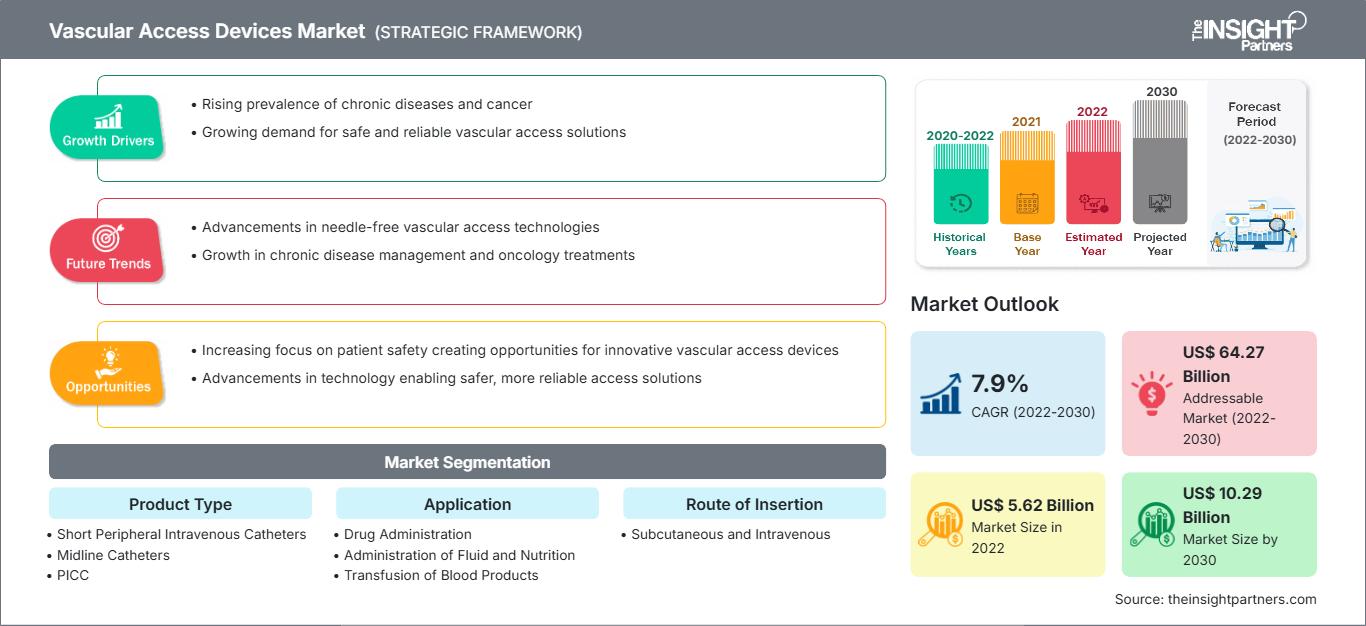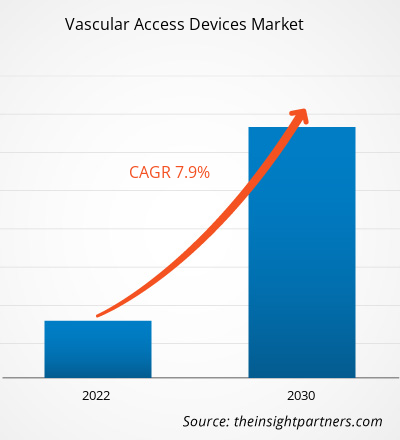[Rapporto di ricerca] Il mercato dei dispositivi di accesso vascolare è stato valutato a 5,62 miliardi di dollari nel 2022 e si prevede che raggiungerà i 10,29 miliardi di dollari entro il 2030. Si prevede che registrerà un CAGR del 7,9% tra il 2022 e il 2030.
Approfondimenti di mercato e punto di vista degli analisti:
I dispositivi di accesso vascolare vengono posizionati utilizzando diversi siti anatomici per accedere alla vena cava superiore o inferiore: vena giugulare interna, vena succlavia, vena giugulare esterna e vena femorale. La crescita del mercato dei dispositivi di accesso vascolare è trainata dalla crescente prevalenza di malattie croniche e dalla crescente necessità di procedure chemioterapiche. Inoltre, le iniziative strategiche delle aziende per rimanere competitive sul mercato alimentano la crescita del mercato. Un aumento significativo nell'uso di dispositivi robotici per l'accesso venoso basati sull'intelligenza artificiale (IA) porterà probabilmente nuove tendenze nel mercato dei dispositivi per l'accesso vascolare durante il periodo di previsione.
Fattori di crescita e sfide:
La chemioterapia è un trattamento primario o adiuvante utilizzato per ridurre o eliminare i tumori attraverso la somministrazione di farmaci potenti. Pertanto, l'aumento dei casi di cancro alimenta la domanda di procedure chemioterapiche. Secondo le stime dell'Agenzia Internazionale per la Ricerca sul Cancro (IARC), nel 2020 sono stati segnalati 19,3 milioni di nuovi casi di cancro a livello globale e circa 10 milioni di decessi a causa della malattia. Secondo il Registro Nazionale dei Tumori (NCR), in Sudafrica sono stati diagnosticati circa 110.000 nuovi casi di cancro, con oltre 56.000 decessi correlati al cancro nel 2020. Inoltre, si prevede che il carico di malattia aumenterà nei prossimi decenni, con un aumento stimato dei nuovi casi di cancro a 138.000 e 175.000 entro il 2030 e il 2040, rispettivamente, mentre la mortalità correlata al cancro salirà a 73.000 e 94.000 negli stessi anni. Pertanto, la crescente prevalenza del cancro traina la crescita del mercato dei dispositivi di accesso vascolare.
Personalizza questo rapporto in base alle tue esigenze
Potrai personalizzare gratuitamente qualsiasi rapporto, comprese parti di questo rapporto, o analisi a livello di paese, pacchetto dati Excel, oltre a usufruire di grandi offerte e sconti per start-up e università
Mercato dei dispositivi di accesso vascolare: Approfondimenti strategici

- Ottieni le principali tendenze chiave del mercato di questo rapporto.Questo campione GRATUITO includerà l'analisi dei dati, che vanno dalle tendenze di mercato alle stime e alle previsioni.
Potrai personalizzare gratuitamente qualsiasi rapporto, comprese parti di questo rapporto, o analisi a livello di paese, pacchetto dati Excel, oltre a usufruire di grandi offerte e sconti per start-up e università
Mercato dei dispositivi di accesso vascolare: Approfondimenti strategici

- Ottieni le principali tendenze chiave del mercato di questo rapporto.Questo campione GRATUITO includerà l'analisi dei dati, che vanno dalle tendenze di mercato alle stime e alle previsioni.
Segmentazione e ambito del rapporto:
L'analisi del mercato dei dispositivi di accesso vascolare è stata condotta considerando i seguenti segmenti: tipologia di prodotto, applicazione, via di inserimento, utente finale e area geografica. Il mercato, per tipologia di prodotto, è segmentato in cateteri endovenosi periferici corti, cateteri midline, PICC (cateteri centrali a inserimento periferico), cateteri centrali, port impiantabili e accessori. Il mercato del segmento dei cateteri centrali è ulteriormente segmentato in CICC (cateteri centrali a inserimento centrale), FICC (cateteri centrali a inserimento femorale) e altri. In base all'applicazione, il mercato dei dispositivi di accesso vascolare è segmentato in somministrazione di farmaci, somministrazione di liquidi e nutrienti, trasfusione di emoderivati e altri. In base alla via di inserimento, il mercato è suddiviso in sottocutaneo ed endovenoso. In base agli utenti finali, il mercato è segmentato in ospedali e cliniche, centri chirurgici ambulatoriali e altri. L'ambito del rapporto sul mercato dei dispositivi di accesso vascolare comprende Nord America (Stati Uniti, Canada e Messico), Europa (Spagna, Regno Unito, Germania, Francia, Italia e resto d'Europa), Asia Pacifico (Corea del Sud, Cina, Giappone, India, Australia e resto dell'Asia Pacifico), Medio Oriente e Africa (Sudafrica, Arabia Saudita, Emirati Arabi Uniti e resto del Medio Oriente e dell'Africa) e Sud e Centro America (Brasile, Argentina e resto del Sud e Centro America).
Analisi segmentale:
Il mercato dei dispositivi di accesso vascolare, per tipologia di prodotto, è segmentato in cateteri endovenosi periferici corti, cateteri midline, PICC (cateteri centrali a inserimento periferico), cateteri centrali, port impiantabili e accessori. Il mercato del segmento dei cateteri centrali è a sua volta suddiviso in CICC (cateteri centrali a inserimento centrale), FICC (cateteri centrali a inserimento femorale) e altri. Nel 2022, il segmento dei cateteri endovenosi periferici corti ha rappresentato la quota di mercato maggiore dei dispositivi di accesso vascolare e si prevede che lo stesso segmento registrerà il CAGR più elevato tra il 2022 e il 2030.
In base all'applicazione, il mercato dei dispositivi di accesso vascolare è segmentato in somministrazione di farmaci, somministrazione di liquidi e nutrienti, trasfusione di emoderivati e altri. Nel 2022, il segmento della somministrazione di farmaci ha detenuto la quota maggiore e si prevede che registrerà il CAGR più elevato tra il 2022 e il 2030.
In base alla via di inserimento, il mercato dei dispositivi di accesso vascolare è suddiviso in sottocutaneo ed endovenoso. Il segmento endovenoso ha detenuto una quota di mercato maggiore nel 2022 e si prevede che registrerà un CAGR più elevato tra il 2022 e il 2030.
In base all'utente finale, il mercato è segmentato in ospedali e cliniche, centri chirurgici ambulatoriali e altri. Il mercato dei dispositivi di accesso vascolare per il segmento ospedaliero e clinico è destinato a crescere nel periodo 2022-2030.
Analisi regionale:
Il Nord America contribuisce maggiormente alla crescita del mercato globale dei dispositivi di accesso vascolare. Si prevede che l'Asia-Pacifico registrerà il CAGR più elevato nel periodo 2022-2030. Il Nord America ha detenuto la quota maggiore del mercato globale nel 2022, grazie alla crescente prevalenza di patologie croniche, all'aumento della popolazione geriatrica, alla presenza di attori chiave del mercato coinvolti nello sviluppo di prodotti nuovi ed esistenti e ai crescenti progressi tecnologici. In Nord America, gli Stati Uniti hanno detenuto la quota di mercato maggiore nel 2022.
Approfondimenti regionali sul mercato dei dispositivi di accesso vascolare
Le tendenze regionali e i fattori che influenzano il mercato dei dispositivi di accesso vascolare durante il periodo di previsione sono stati ampiamente spiegati dagli analisti di The Insight Partners. Questa sezione illustra anche i segmenti e la geografia del mercato dei dispositivi di accesso vascolare in Nord America, Europa, Asia-Pacifico, Medio Oriente e Africa, America meridionale e centrale.
Ambito del rapporto di mercato sui dispositivi di accesso vascolare
| Attributo del rapporto | Dettagli |
|---|---|
| Dimensioni del mercato in 2022 | US$ 5.62 Billion |
| Dimensioni del mercato per 2030 | US$ 10.29 Billion |
| CAGR globale (2022 - 2030) | 7.9% |
| Dati storici | 2020-2022 |
| Periodo di previsione | 2022-2030 |
| Segmenti coperti |
By Tipo di prodotto
|
| Regioni e paesi coperti | Nord America
|
| Leader di mercato e profili aziendali chiave |
|
Densità degli operatori del mercato dei dispositivi di accesso vascolare: comprendere il suo impatto sulle dinamiche aziendali
Il mercato dei dispositivi di accesso vascolare è in rapida crescita, trainato dalla crescente domanda degli utenti finali, dovuta a fattori quali l'evoluzione delle preferenze dei consumatori, i progressi tecnologici e una maggiore consapevolezza dei benefici del prodotto. Con l'aumento della domanda, le aziende stanno ampliando la propria offerta, innovando per soddisfare le esigenze dei consumatori e sfruttando le tendenze emergenti, alimentando ulteriormente la crescita del mercato.

- Ottieni il Mercato dei dispositivi di accesso vascolare Panoramica dei principali attori chiave
Sviluppi del settore e opportunità future:
Le previsioni di mercato dei dispositivi di accesso vascolare sono stimate sulla base di vari risultati di ricerche primarie e secondarie, come pubblicazioni aziendali chiave, dati di associazioni e database. Secondo i comunicati stampa pubblicati dai principali attori del mercato, di seguito sono elencate alcune strategie:
- Nel novembre 2023, BD (Becton, Dickinson and Company) ha lanciato una nuova tecnologia di prelievo del sangue senza ago, compatibile con i cateteri integrati, contribuendo a realizzare la visione dell'azienda di una "degenza ospedaliera con un solo ago". Il dispositivo per il prelievo di sangue senza ago PIVO Pro presenta miglioramenti progettuali per garantire la compatibilità con cateteri EV periferici integrati e lunghi, tra cui il nuovo sistema di catetere EV chiuso Nexiva con accesso EV NearPort.
- A maggio 2023, Teleflex Inc. ha lanciato due nuovi dispositivi, il dispositivo Arrow VPS Rhythm DLX e il mandrino NaviCurve, progettati per migliorare le procedure di inserimento del PICC e ridurre il rischio di complicanze. Il dispositivo VPS Rhythm DLX fornisce informazioni in tempo reale sulla posizione della punta del catetere utilizzando l'attività elettrica cardiaca del paziente. Lo stiletto NaviCurve presenta una curvatura anatomica e una punta flessibile, progettate per autoorientarsi in base all'anatomia del paziente, migliorando l'avanzamento del PICC nella vena cava superiore (SVC) per un inserimento di successo.
Panorama competitivo e aziende chiave:
Teleflex Inc, BD, B. Braun SE, Terumo Medical Corporation, Medtronic, Fresenius Kabi, Baxter, Vygon SAS, Kimal e Access Vascular Inc sono tra i principali attori descritti nel rapporto di mercato sui dispositivi di accesso vascolare. Inoltre, diversi altri attori sono stati studiati e analizzati durante lo studio per ottenere una visione olistica del mercato e del suo ecosistema. Queste aziende si concentrano sull'espansione geografica e sul lancio di nuovi prodotti per soddisfare la crescente domanda dei consumatori in tutto il mondo e ampliare la loro gamma di prodotti nei portafogli specialistici. La loro presenza globale consente loro di servire un'ampia base di clienti, facilitando di conseguenza l'espansione del mercato.
- Analisi storica (2 anni), anno base, previsione (7 anni) con CAGR
- Analisi PEST e SWOT
- Valore/volume delle dimensioni del mercato - Globale, Regionale, Nazionale
- Industria e panorama competitivo
- Set di dati Excel
Report recenti
Testimonianze
Motivo dell'acquisto
- Processo decisionale informato
- Comprensione delle dinamiche di mercato
- Analisi competitiva
- Analisi dei clienti
- Previsioni di mercato
- Mitigazione del rischio
- Pianificazione strategica
- Giustificazione degli investimenti
- Identificazione dei mercati emergenti
- Miglioramento delle strategie di marketing
- Aumento dell'efficienza operativa
- Allineamento alle tendenze normative




















 Ottieni un campione gratuito per - Mercato dei dispositivi di accesso vascolare
Ottieni un campione gratuito per - Mercato dei dispositivi di accesso vascolare